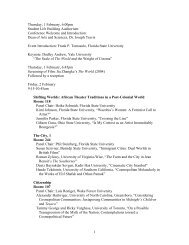Visibility now: Historicizing foreign presences in translation - English ...
Visibility now: Historicizing foreign presences in translation - English ...
Visibility now: Historicizing foreign presences in translation - English ...
Create successful ePaper yourself
Turn your PDF publications into a flip-book with our unique Google optimized e-Paper software.
Downloaded by [Florida State University], [Anne Coldiron] at 07:12 30 March 2012<br />
Translation Studies,<br />
Vol. 5, No. 2, 2012, 189 200<br />
<strong>Visibility</strong> <strong>now</strong>: <strong>Historiciz<strong>in</strong>g</strong> <strong>foreign</strong> <strong>presences</strong> <strong>in</strong> <strong>translation</strong><br />
A.E.B. Coldiron*<br />
Florida State University, Tallahassee, and The Folger Shakespeare Library, Wash<strong>in</strong>gton DC,<br />
USA<br />
<strong>Visibility</strong> is proposed <strong>in</strong> this article as an <strong>in</strong>verse corollary to Venuti’s notion of<br />
<strong>in</strong>visibility and a site of methodological <strong>in</strong>terest for <strong>translation</strong> history. By<br />
historiciz<strong>in</strong>g the visibility of translators and of other <strong>foreign</strong> elements <strong>in</strong><br />
<strong>translation</strong>s and paratexts, we can trace broader cultural-aesthetic agendas<br />
related to <strong>translation</strong> as they change over time. This essay demonstrates such<br />
changes <strong>in</strong> medieval and Renaissance <strong>translation</strong>s. Imped<strong>in</strong>g the practice and<br />
study of visibility have been ideologies strongly favor<strong>in</strong>g <strong>in</strong>visibility, such as those<br />
ultimately derived from the Western discipl<strong>in</strong>e’s found<strong>in</strong>g myth of Babel, or from<br />
post-Romantic notions of literary value. But the visibility of the <strong>foreign</strong> has<br />
been and is, <strong>in</strong> contemporary, experimental and digital <strong>translation</strong>s a potential<br />
aesthetic resource, a locus of friction and <strong>in</strong>terest, and an <strong>in</strong>dex to historically<br />
chang<strong>in</strong>g attitudes to alterity.<br />
Keywords: visibility <strong>in</strong> <strong>translation</strong>; medieval <strong>translation</strong>; Renaissance <strong>translation</strong>;<br />
contemporary <strong>translation</strong>; Philip Sidney<br />
In one sense, the history of <strong>translation</strong> records efforts to mediate alterity, to make<br />
alien cultures comprehensible to one another. The visibility or <strong>in</strong>visibility of such<br />
mediat<strong>in</strong>g efforts turns out to matter a good deal to literary history; the present essay<br />
has several aims regard<strong>in</strong>g visible (and <strong>in</strong>visible) <strong>translation</strong>. The first aim is to reexam<strong>in</strong>e<br />
Lawrence Venuti’s key notion of The Translator’s Invisibility (1995/2008),<br />
extend<strong>in</strong>g this major concept both back <strong>in</strong>to the medieval and early modern periods<br />
and forward, briefly, <strong>in</strong>to our own moment and its digital future. In re-historiciz<strong>in</strong>g<br />
<strong>in</strong>visibility, we f<strong>in</strong>d that its implied corollary, or mirror notion, visibility, has also<br />
frequently served the values of particular literary-historical moments. Thus a second<br />
aim is to emphasize <strong>in</strong>visibility’s alter idem, visibility, and its uses. Another aim here<br />
is to recover for <strong>translation</strong> studies some generative potentials of visibility even<br />
beyond the ‘‘Call to Action’’ <strong>in</strong> Venuti’s f<strong>in</strong>al chapter. If we expand Venuti’s powerful<br />
concept to <strong>in</strong>clude more generally the <strong>in</strong>/visibilities of all <strong>foreign</strong> elements <strong>in</strong> a text, as<br />
his own hermeneutic practice has tended to do, then the visibly <strong>foreign</strong> elements <strong>in</strong><br />
<strong>translation</strong>s may appear not only as sites of resistance that br<strong>in</strong>g to light the toooften<br />
suppressed labor and art of translators, but also as aesthetic successes of<br />
collaborative <strong>in</strong>tertextuality, and perhaps even as ethical models for encounter<strong>in</strong>g<br />
alterity. 1<br />
Questions of visibility and <strong>in</strong>visibility are on some level questions of how to<br />
encounter, use and value th<strong>in</strong>gs <strong>foreign</strong>. Where <strong>in</strong>visibility of <strong>foreign</strong> elements and<br />
mediat<strong>in</strong>g translators po<strong>in</strong>ts to devaluations of the <strong>foreign</strong> or at least to problems <strong>in</strong><br />
*Email: acoldiron@fsu.edu<br />
ISSN 1478-1700 pr<strong>in</strong>t/ISSN 1751-2921 onl<strong>in</strong>e<br />
# 2012, Taylor & Francis<br />
http://dx.doi.org/10.1080/14781700.2012.663602<br />
http://www.tandfonl<strong>in</strong>e.com




